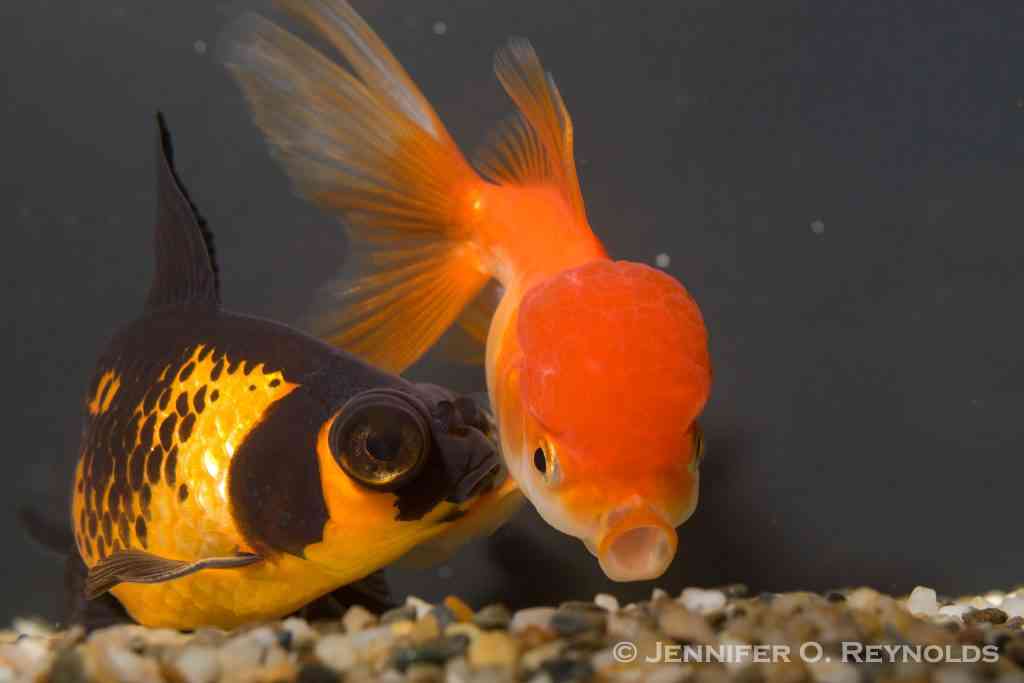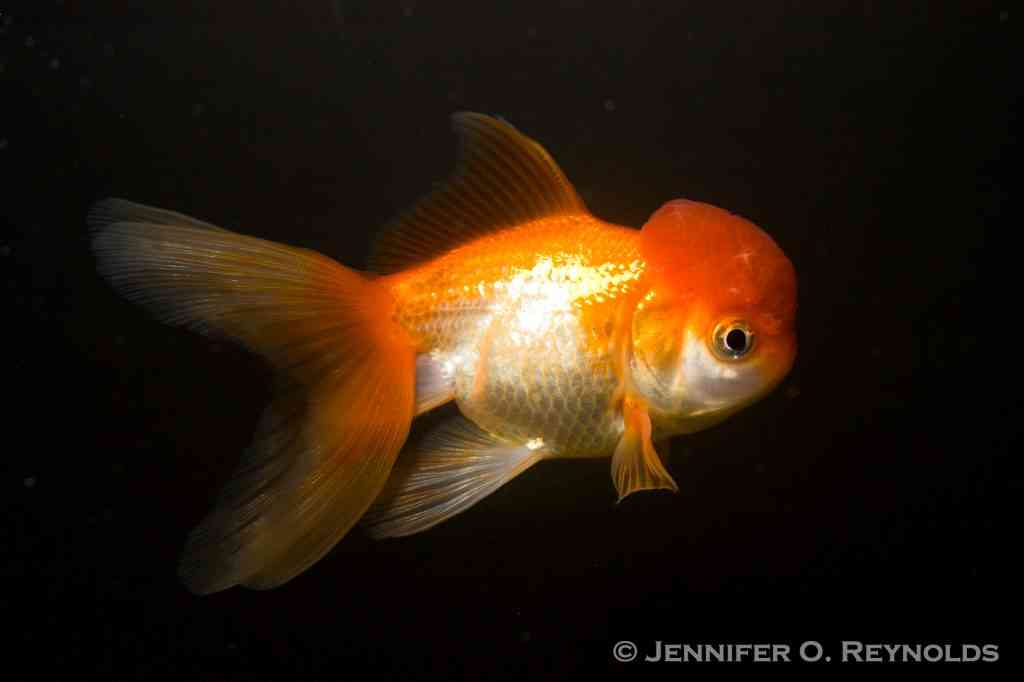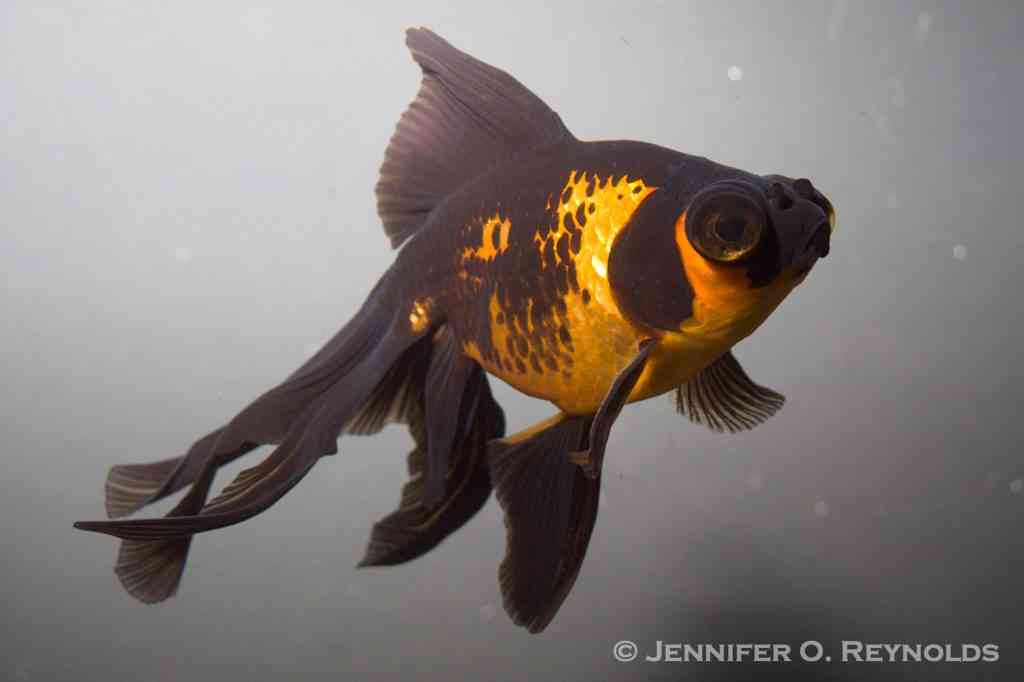Jennifer O. Reynolds, M.A. & Nora Hickey, D.V.M.
Jen and Nora discuss feeding goldfish, covering common problems that can occur, unique goldfish anatomy, what and how often to feed your goldfish, and supplemental treats, vegetables, and plants that can enrich their diet.

Nora: Jen, I had a very good question from a fellow veterinarian and avid fancy goldfish keeper who asked what the best diet is for her goldfish. She has a fancy goldfish that was having buoyancy problems after eating, and we wondered if maybe she needed to improve her fish’s diet. This seems like a question many goldfish keepers might have, so let’s talk about it! What can you share with us about goldfish and their diets?
Jen: It warms my heart to hear of a vet keeping goldfish. They’re such charming fish. I absolutely have a soft spot for black moors and fantails. Goldfish aren’t very picky about their food, so they’ll try almost anything you offer, even if it isn’t the healthiest choice.
Naturally, they are omnivorous and their diet would contain insects, insect larvae, plants, algae, detritus, zooplankton or small crustaceans, for example. So we should be looking to provide some approximation of this for captive goldfish.
It is especially common for fancy goldfish to have buoyancy problems related to eating. This goes back to the many years of selective breeding they’ve undergone to achieve those unusual body shapes.
Nora: I think of fancy goldfish as the “pugs” of the fish world. They have all sorts of unique traits that have been selected for that can negatively impact their health, including buoyancy problems. What I thought was particularly interesting about my friend’s goldfish was that the buoyancy problems seemed to happen after she fed her fish. There are a lot of causes of buoyancy problems, but it made me think about goldfish and their need for a lot of plant material in their diets. What suggestions would you have for my friend about ways to incorporate more plants into Orange Chicken Nugget’s diet (great name for a goldfish, right!)?

Jen: It’s a great name. Hah!
Buoyancy problems could be related to more than one thing. Depending on the type of food being offered now, it’s possible that Orange Chicken Nugget might do better with more plant matter, but it’s also possible that the choice of prepared food could impact the buoyancy problems. Some pellet food for goldfish is floating, and flakes will also hang on the surface unless the aquarist places them under the surface when feeding. This could lead the goldfish to gulping air. Some solutions could be to offer sinking pellets, or even to briefly soak food before feeding, although not for too long as you wouldn’t want to deplete water-soluble vitamins.
Goldfish like to scavenge and search on the bottom for food. Rounded gravel can be a good choice for their substrate so they can spend time searching through it to eat. Sinking goldfish pellets could fall between gravel and cause some mess, but it would be worth trying if small amounts were offered at a time, to avoid leftovers.
In terms of adding more plant material, there are a few ways to do this. The first one that comes to mind for me is considering growing some duckweed, a small floating plant. Many goldfish will eat this. It’s so easy to grow that it’s considered a nuisance for many planted aquarium keepers. Your friend could get duckweed from almost any fish store or hobby club and grow it in a container on a windowsill or in another aquarium and add some small amounts. Other easy options would be shelled and blanched frozen green peas, which goldfish seem to relish. Other vegetables can be blanched and offered too. You can use a small suction cup clip or a small rock to sink the vegetables down after they’ve been softened. Lettuce, zucchini, and green beans are all options that goldfish and many other fish enjoy.
Something that’s super interesting though is how goldfish differ anatomically from the other fish we commonly keep.
Nora: Yes, goldfish have several unique anatomical features that are worth mentioning here! I think the most striking thing to me is that they have a bilobed swimbladder, which means that the gas-filled organ they use to control their buoyancy has two compartments. I wonder if this is one of the contributors to their frequent buoyancy problems.
More pertinent to our discussion here is that goldfish don’t have a true stomach. They have pharyngeal teeth to help with grinding up food, and they have a very long intestinal tract. This is similar to terrestrial herbivores like horses and cattle, which have very long intestinal tracts to help them better absorb nutrients from plants.
If you go into the fish store and look through the ingredients on the fish flakes or pellets for sale, you will notice that almost all of them have fish meal listed as the first ingredient. This probably isn’t the best choice for goldfish, but it’s not easy to find a flake or pellet food with more plant ingredients!

Jen: Yeah, that is so interesting that they don’t have a true stomach! Your comparison to terrestrial herbivores also makes a lot of sense, because goldfish also continuously graze on plant matter throughout the day.
I do think there is more awareness these days of the specific dietary needs of different aquarium fish. I’ve seen some great options that are based primarily on black soldier fly larvae, such as Bug Bites, a food we also like for bettas. Pellets or flakes designed for goldfish are generally lower protein, so that’s a step in the right direction. There are also spirulina flakes and algae wafers marketed for herbivorous mbuna cichlids and catfish that can be a good addition to a goldfish’s diet.
Of course, one of the reasons people love goldfish is right in the name—their bright colors. Many foods claim to enhance goldfish colors, and these can be good choices too if the basic diet itself is dialed in for goldfish. In the past, paprika was a popular home fish food ingredient because it contains carotenoid pigments that can help enhance fish colors. Many fish foods now contain astaxanthin, a natural pigment found in krill which is what gives flamingos and scarlet ibises their amazing color. It is also used in salmon feed to give farmed salmon filets a pink color. Astaxanthin and spirulina algae, which also has carotenoid pigments in it, are good ingredient options for keeping your goldfish bright and beautiful.

Nora: Speaking of goldfish’s striking colors, I remember a very beautiful eyeless silver goldfish that I brought home from PetSmart when I worked there in high school. This fish inspired me to start an entire goldfish tank. I remember one of my biggest challenges with this tank was keeping it clean, because goldfish can be quite dirty! Not overfeeding was a very important part of maintaining that tank. What are your recommendations for how our readers should be feeding their goldfish?
Jen: First, for a core diet, look for foods that are formulated for goldfish. From there, look for foods that ideally have some insect larvae, and plants or algae as ingredients. Bug Bites goldfish formula is a great example, as it has soldier fly larvae meal as a first ingredient, but is designed to be low in protein. Their flakes also have peas as an ingredient, and their pellets are slow-sinking.
A core diet like this can be supplemented a couple of times a week with treats such as frozen bloodworms, Daphnia and plant matter including green peas (frozen with skin removed & blanched is easiest), algae wafers, duckweed, or other softened vegetables. For most goldfish, a small feeding 1-3 times per day works well.
These more frequent but modest feedings can help approximate their propensity for grazing. It’s important to only feed the amount they can enthusiastically consume in a couple of minutes at most, as overfeeding could lead to leftover food that fouls the aquarium water. Human-made fish food is also naturally higher in calories than the algae and plant matter that would represent much of their diet in nature. Young goldfish grow quickly, so they benefit from three feedings per day, while older goldfish can better tolerate less frequent feedings. However, it’s no problem for them to have a fasting day every couple of weeks, or to be left for a few days if you are away on vacation.
Nora: Agreed, far more fish die from being overfed during vacation than being left without food for a few days.
Jen: Goldfish love to eat and can be quite adorable beggars. How could someone tell if they are feeding the right amount? What should their goldfish’s body condition look like?
Nora: That is an unfair question considering what crazy body shapes goldfish can have—they are really hard to assess for body condition!!! But, in general, non-fancy goldfish like comets should have a slim torpedo-shaped profile when viewed from above, and they shouldn’t have a potbelly when viewed from the side.
It’s harder to tell with fancy goldfish because of their different body shapes, but I think signs like struggling to swim or maintain neutral buoyancy can be indicators of an overweight fish, although these can also be caused by other health problems. Every goldfish is unique, and different goldfish will respond best to different types and amounts of food.
The showy forms and colors of goldfish combined with their fun personalities have earned goldfish a well-deserved place in the aquarium hobby. They continue to be very popular fish for beginners and advanced aquarists alike. Proper nutrition and feeding is a critical part of ensuring that these fish live their best lives under our care. Happy goldfish keeping everyone!

Reputable Resources:
Stoskopf, Michael K., ed. Fish Medicine: Volume II, Second Edition. 2010.

